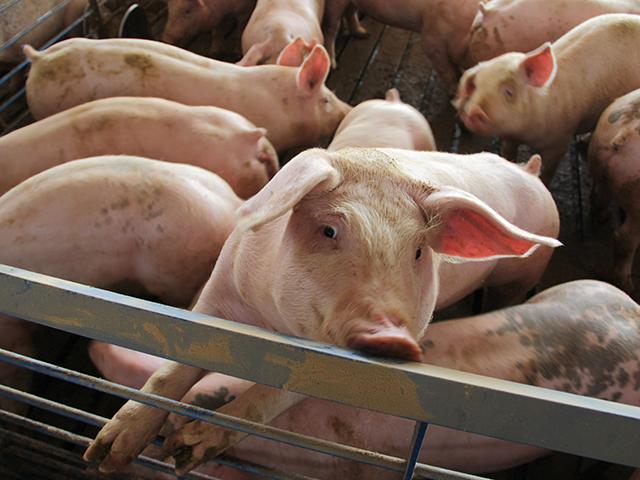USDA to Allow Faster Plant Line Speeds
USDA Resurrects Program to Allow Faster Line Speeds at Pork Production Plants
LINCOLN, Neb. (DTN) -- USDA will again allow faster line speeds in a select few pork processing plants as part of a pilot project after a federal court in Minnesota vacated a USDA rule earlier this year.
Pork plants in Pennsylvania, Michigan, Nebraska and Minnesota had been working with the faster line speeds as part of a pilot program for a number of years. Another plant in Oklahoma increased line speeds in 2019, as well.
The U.S. District Court for the District of Minnesota struck down a provision of USDA's New Swine Inspection System, or NSIS, allowing for faster harvest-facility line speeds. NSIS was initiated during the Clinton administration and was evaluated at five pilot plants during the past 20 years.
USDA said in a statement to DTN it will allow existing NSIS facilities to apply for up to a one-year trial to operate at increased line speeds.
"During which time an establishment would implement worker safety measures included in an agreement with its workers' union or worker safety committee," USDA said.
"The trial will facilitate experimentation with different ergonomics, automation and crewing to design custom-work environments that increase productivity and protect food safety while decreasing the probability of worker injuries."
USDA said the facilities would collect data to measure the effect of line speed on workers, "which will be shared with OSHA (Occupational Safety and Health Administration) and could inform future rulemaking in this area."
Plant line speeds have received more attention during the recent COVID-19 shutdown, as in 2020, the closure of meat production plants because of the virus led to livestock losses for farmers who couldn't have animals processed.
The National Pork Producers Council said the move by USDA comes at an important time for pork producers.
P[L1] D[0x0] M[300x250] OOP[F] ADUNIT[] T[]
"This is particularly important now given the strong demand for pork, supply chain problems and our industry's packing capacity constraints," said NPPC President Jen Sorenson.
There were nine plants that adopted USDA's 2019 New Swine Inspection System. Those plants will be allowed to apply for a one-year trial program.
The line speed provision of the 2019 NSIS final rule was more than 20 years in the making, according to NPPC, with six pork plants operating faster line speeds through a program launched by the Clinton administration in 1997.
"We believe the 20-year pilot program demonstrated that increased line speeds and protecting worker safety are not mutually exclusive," Sorenson said.
"We are optimistic that this new program, with OSHA involvement, will result in more pork for consumers without sacrificing worker safety."
In March, the federal court in Minnesota struck down the NSIS line speeds provision, ruling USDA did not consider worker safety in the final rule.
According to the NPPC, when the court's ruling took effect on July 1, 2021, the pork industry lost about 2.5% of its harvest capacity.
"With the reduction in packing capacity because of the court's line speed decision, some pork producers lost market leverage and had fewer options for selling their hogs," NPPC said in a news release.
"The ruling also opened the door for packers to exercise the force majeure clause to cancel contracts with producers, which would compel some producers to find other harvest facilities with capacity and likely require many to transport hogs long distances."
Sorenson said although the industry is less concentrated and has more plants and capacity than it did five years ago, "capacity remains very tight.
"That shortfall has been exacerbated not only by the court's line-speed decision but also by the industry's severe labor shortage, including a shortage of USDA FSIS inspectors at harvest facilities, inhibiting the ability of the facilities to operate at full capacity."
Back in June, a handful of federal lawmakers asked U.S. Secretary of Agriculture Tom Vilsack and a U.S. Department of Justice official to act following the court ruling.
In a letter to Vilsack and DOJ Solicitor General Elizabeth Prelogaron, Sen. Charles Grassley, R-Iowa, and Reps. Jim Hagedorn, R-Minn., and Dusty Johnson, R-S.D., requested the agencies to take action to minimize the damage to the industry.
The lawmakers said unless the DOJ or USDA acts, the pork industry could see a wave of consolidation.
Read more on DTN:
"New Pork Inspection Rule," https://www.dtnpf.com/…
"Federal Lawmakers Lean on Vilsack, DOJ to Act on Line Speeds at Pork Packing Plants," https://www.dtnpf.com/…
Todd Neeley can be reached at todd.neeley@dtn.com
Follow him on Twitter @DTNeeley
(c) Copyright 2021 DTN, LLC. All rights reserved.




